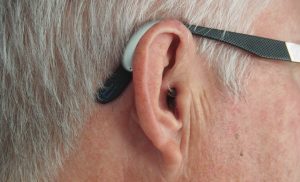Hearing Loss and Central Auditory Processing
60 Hearing Aids
Learning Objectives
Understand which hearing aids are most effective in what cases of hearing loss and why.
Know the main features of hearing aids.
Be able to discuss the prevalence of hearing aids.
Hearing aids amplify sound, so they rely on functioning hair cells. Hearing aids do not restore normal hearing when used to treat sensorineural loss, because the effects of neural damage are so complicated.

Modern hearing aids have, in addition to basic sound amplification, these features: amplitude compression (mimicking the natural compressive response of the inner ear, which you lose when you lose outer hair cells; this reduces Loudness Recruitment), and noise reduction—a filtering algorithm that tries to take out background noise. Noise reduction improves comfort but doesn’t improve speech intelligibility, and the algorithm doesn’t know which sound you’re trying to pick out and might reduce the wrong sound. Current research is trying to use brain-steering: an EEG signal can detect which speech sound you’re paying attention to, and this can be used to control amplification. Maybe someday.
Styles of Hearing Aids:
Behind-the-ear (BTE) aids have most parts contained in a small plastic case that rests behind the ear. The case is connected to an earmold or an earpiece by a piece of clear tubing. This style is often chosen for young children because it can accommodate various earmold types, which need to be replaced as a child grows. Also, BTE aids are easy to clean and handle, and are relatively sturdy.
“Mini” BTE, or receiver in canal (RIC) aids are a type of BTE aid that fits behind the ear, but is typically smaller in size. A narrow tube is used to connect the aid to the ear canal. Mini BTEs may have a smaller earpiece for insertion, but may also use a traditional earmold. These earpieces may reduce the occlusion effect in the ear canal—a plugged up sensation that causes a hearing aid user’s voice to sound louder inside the head—and increase comfort, reduce feedback, and address cosmetic concerns for many users.
In-the-ear (ITE) aids have all parts of the hearing aid contained in a shell that fills in the outer part of the ear. The ITE aids are larger than the in-the-canal and completely-in-the-canal aids, and may be easier to handle than smaller aids.
In-the-canal (ITC) aids and completely-in-the-canal (CIC) aids are tiny cases that fit partly or completely into the ear canal. They are the smallest hearing aids available and offer cosmetic and some listening advantages. However, their small size may make them difficult to handle and adjust.
Only about a quarter of the people who would benefit from hearing aids actually use them. Adoption rates are higher (30-40%) in countries like Norway where insurance covers hearing aids. These low rates may be due to the $2k-$3k price tag that insurance often may not cover. Another thing that keeps adoption rates down is that they really don’t help in all situations. On the bright side, new FDA regulations are coming out that might create over-the-counter hearing aids and bring down the price!
CC LICENSED CONTENT, SHARED PREVIOUSLY
OpenStax, Psychology Chapter 5.4 Hearing
Provided by: Rice University.
Download for free at http://cnx.org/contents/4abf04bf-93a0-45c3-9cbc-2cefd46e68cc@5.103.
License: CC-BY 4.0
Adapted by: Grace Cumming & Kori Skrypek
U.S. Food and Drug Administration (FDA), Types of Hearing Aids
Provided by: U.S. Department of Health and Human Services
Download for free at https://www.fda.gov/medical-devices/hearing-aids/types-hearing-aids#2
License: Creative Commons CC0 1.0 Universal
Adapted by: Elle Woog
Cheryl Olman PSY 3031 Detailed Outline
Provided by: University of Minnesota
Download for free at http://vision.psych.umn.edu/users/caolman/courses/PSY3031/
License of original source: CC Attribution 4.0
Adapted by: Kori Skrypek

